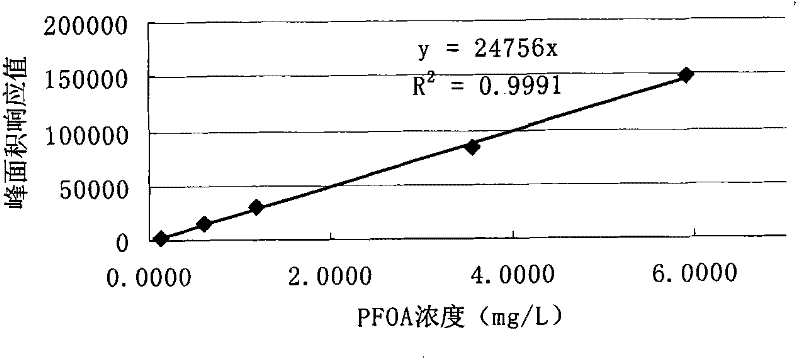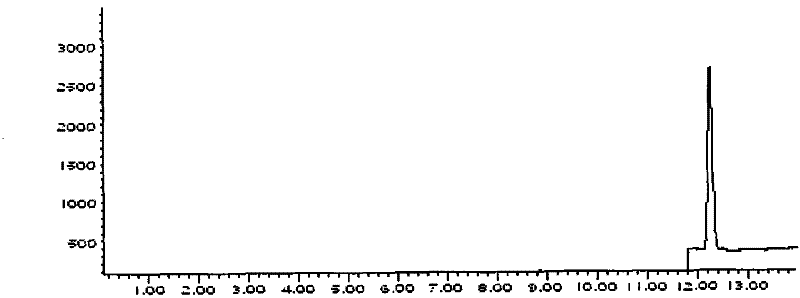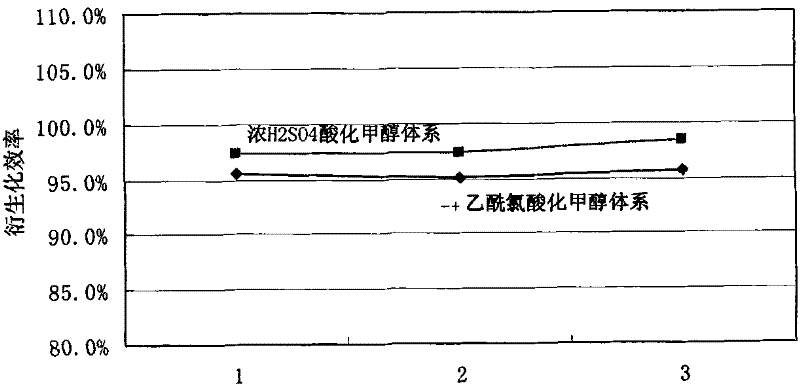A method for quantitatively detecting perfluorooctanoic acid and its salts in fluororubber
A technology for the quantitative detection of perfluorooctanoic acid, which is applied in measuring devices, instruments, scientific instruments, etc., can solve the problems of expensive instruments, difficulty in widespread promotion, and high quantitative sensitivity of the SIM method, and achieves less interference from impurities, simple derivatization steps, and reproducible results good sex effect
- Summary
- Abstract
- Description
- Claims
- Application Information
AI Technical Summary
Problems solved by technology
Method used
Image
Examples
Embodiment 1
[0022] 1. Instrument
[0023] American Agilent 6892-5973N gas spectrometer;
[0024] Porous vacuum extraction device with large volume sampling tube.
[0025] 2. Chromatographic conditions
[0026] Chromatographic column: DB-1ms 30m×0.32mm×0.10μm;
[0027] Column temperature: 100°C;
[0028] Vaporization chamber: 260°C;
[0029] Ion source: 150°C;
[0030] Quadrupole: 230°C;
[0031] Injection volume: 0.5 μL, split ratio 1:10;
[0032] SIM ions: Monitoring m / z 59, 69, 131 started at 11.8 minutes.
[0033] 3. Sample analysis
[0034] The quantitative method adopts the external standard curve method, and the external standard curve is measured by the prepared PFOA standard.
[0035] Prepare standard solutions of perfluorooctanoic acid with mass concentrations of 0, 0.1, 0.5, 1.2, 3.5, and 6 mg / L, perform GC / MS analysis after derivatization, and obtain a regression curve as figure 1 As shown, the correlation coefficient is 0.9991, and the equation is as follows:
[003...
Embodiment 2
[0043] Prepare a 1.00mg / L perfluorooctanoic acid aqueous solution, select CHROMABOND EASY and HR-P SPE cartridges from MN Company in Germany, and BESEP Carbon carbon black cartridges for solid phase extraction enrichment, dry the extraction cartridge with high-purity nitrogen, and use 5ml methanol The dried extraction column was eluted at a rate of 1 ml / min, and the eluate was collected in a headspace bottle with a volume of 10 ml, purged with nitrogen, and concentrated to 2 ml. Add 0.2 g of analytically pure concentrated sulfuric acid to the concentrated eluate, seal it, place it in a water bath at 70°C for 60 min, and cool it down. Extract with 2ml of n-hexane, constant volume, analyze with GC / MS, carry out recovery determination, the result is shown in Table 2.
[0044] Table 2 SPE average recovery
[0045]
[0046] It can be seen from this example that better solid-phase extraction efficiency can be obtained by using CHROMABOND EASY solid-phase extraction cartridges. ...
Embodiment 3
[0048] Acetyl chloride and absolute ethanol were prepared as a derivatization reagent at a volume ratio of 1:20.
[0049] Carry out 3 parallel experiments, add 10%wt analytically pure concentrated sulfuric acid to 2ml 1.00mg / L PFOA methanol solution, seal and place in a water bath at 70°C for 60min derivatization, and cool down. Extract with 2ml of n-hexane, constant volume, and analyze by GC / MS.
[0050] Carry out 3 parallel experiments, add 2ml of methanol derivatization reagent acidified with acetyl chloride to 2ml of 1.00mg / L PFOA methanol solution, seal and place in a water bath at 70°C for 60min to derivatize, then cool. Extract with 2ml of n-hexane, constant volume, and analyze by GC / MS.
[0051] The derivatization efficiencies of two different acidification systems are shown in Table 3, and the trend diagrams are shown in image 3 shown.
[0052] Table 3 Derivatization efficiency of different derivatization systems
[0053]
[0054] It can be seen from Table 3 t...
PUM
| Property | Measurement | Unit |
|---|---|---|
| thickness | aaaaa | aaaaa |
| correlation coefficient | aaaaa | aaaaa |
Abstract
Description
Claims
Application Information
 Login to View More
Login to View More - R&D
- Intellectual Property
- Life Sciences
- Materials
- Tech Scout
- Unparalleled Data Quality
- Higher Quality Content
- 60% Fewer Hallucinations
Browse by: Latest US Patents, China's latest patents, Technical Efficacy Thesaurus, Application Domain, Technology Topic, Popular Technical Reports.
© 2025 PatSnap. All rights reserved.Legal|Privacy policy|Modern Slavery Act Transparency Statement|Sitemap|About US| Contact US: help@patsnap.com



